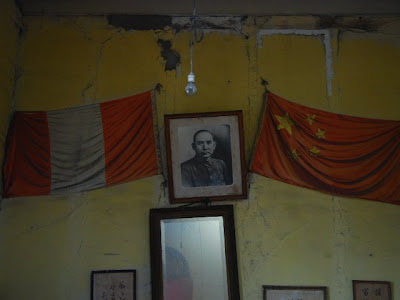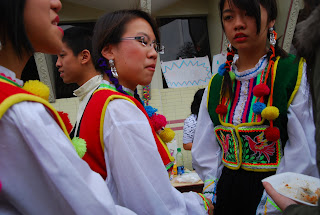"
Chifa" is the word used to describe Chinese food in Peruvian Spanish, a slight corruption of the Chinese compound
chi-fan, literally translated as "Eat Food." Chifa seems to be ubiquitous in Lima, even outside the Chinatown area. In my district, Miraflores, there are two Chifas only two minutes away from my apartment building. It appears as if the Chinese influence in Peru has at least permeated its cuisine, and foods such as
sopa wanton and
chaufa (fried rice) are found everywhere. Often after attempting to explain my project to Peruvians, I ask them if they've had Chifa, and if so, if they like it. I have yet to meet a single Peruvian (or more specifically, someone from Lima) who isn't aware of the Chinese population here, or who hasn't tried Chinese food. They have all said that they like it, but that may be a different matter.
The Chinese have settled in Peru for over hundred years, and continue to do so today. Lima's Chinatown is one of the most established in the Western Hemisphere, and is perhaps the most famous Chinatown outside of the United States. Geographically, however, "El Barrio Chino" (the Chinatown) is quite small -- it is composed of only two perpendicular streets, Calle Uyacali and Calle Capon.
I arrived in Lima one week ago, and I quickly obesrved that the Chinese community here in Peru isn't really a unified entity. Similar to the Chinese community in, say, New York, the Chinese community in Lima is an eclectic mix of recent immigrants, first-generation Chinese (such as myself), and descendants of Chinese immigrants who arrived here as early as the mid-1800s.
Cantonese immigrants were the first settlers in Peru. Many of their descendants are already well-integrated into Peruvian society, no longer speak Cantonese, and seem to separate themselves from the more recent immigrants. These different groups don't necessarily interact on equal terms, either.
Roxane Lok, who works at a foodstuffs store, arrived from Guangdong less than ten years ago. She was friendly with me on my first day in Barrio Chino, and was willing to pose for a photograph with her boss, Julia, a Peruvian-born woman of Chinese descent, called
tusan, another Peruvian Spanish term that is derived from the Chinese
tusheng, or locally-born.
Roxane appeared quite aware of the disparities between these two groups. I asked the two where they live, and Julia replied San Isidro, a posh suburb where private guards and electric fences are the norm; whereas Roxane replied El Barrio Chino, which despite its touristy veneer, is the first stop for many newly-arrived immigrants. Roxane simplified the difference between these two groups as symbolic of her relationship with Julia, "
La duena y la trabajadora" (The Boss and The Worker).
Most recent immigrants have also arrived from Guangdong, but many more have come from another southern coastal province that has historically sent many immigrants abroad, Fujian. Mr. Lu, an acupuncturist in the Barrio Chino, estimates that within the past eight years the Fujianese population here expanded from only 200 to over 5,000. I don't know whether that is true, but many of the new Chifas that are popping up around the two main streets of the Barrio Chino are run by Fujianese.
Mr. Lu
Mr. Lu, however, does not fit into either of the two predominant categories of Chinese here; he is neither a part of the recent migration from the southern provinces nor is he a descendant of early settlers. Mr. Lu is from Shanghai, and at the age of fifty-five, he managed to get a visa out of China in 1987 (do the math... I did). Unlike most of the other Chinese here, too, Mr. Lu seems enamored of his adopted country and highly critical of his country of birth.
Mr. Lu almost immediately began describing to me the great freedoms he had in Peru, that although China's economy has opened up, its government still hasn't, and that the Chinese are all after money whereas the Peruvians are much more humane. More than once, Mr. Lu grandly described the "libertad" in Peru, which he asserted was near-absent in China.
Mr. Lu's age already hinted at the fact that he undoubtedly lived through some of the most traumatic periods in Chinese history -- the Great Proletarian Cultural Revolution during the 1960s and 1970s. Mr. Lu's iconoclastic comments further contributed to a suspicion that he must have endured unspeakable hardships in China. One common theme that will undoubtedly run through this project is attempting to understand why people left China, and perhaps more historically, under what conditions they left.
Because of my thesis work on China's barefoot doctors (
Chijiao yisheng) during the Cultural Revolution, I was interested in whether Mr. Lu had trained any doctors, since he had already finished medical school (in Chinese medicine) by 1961, at the Medical University in Anhui province. While writing my thesis, I learned that China was able to rapidly train over 1.5 million "barefoot doctors" -- minimally trained rural paramedics -- largely through the help of forced rural conscription of urban doctors.
He said that he was "sent down" (
xiaxiang) to the countryside in the late 1960s, which was quite common for urban residents with the wrong politics, and yes, he trained many barefoot doctors in rural Anhui, as well as "worker's doctors" (
gongren yisheng) outside of Shanghai. During the Cultural Revolution many political undesirables -- intellectuals, "capitalist roaders," teachers, doctors -- were forcibly sent to the countryside to engage in grueling manual labor.
Mr. Lu also indicated that he would not have been able to go to medical school later on, because as he put it, his parents had a
"hacienda." The nice thing about talking with these Chinese-Peruvians is that when my Chinese fails (i.e., I had forgotten had to say "landowners" in Chinese), we can often switch to Spanish. Both Chinese and Spanish are currently occupying the very small space my brain has allocated for foreign languages, so mixing up the two is inevitable. Back to the Hacienda. Shortly after Mr. Lu must have entered medical school in 1957, class struggles would have made it impossible for Mr. Lu, the son of landowners, to attend a medical school. On the other hand, those who had grown up as peasants or landless laborers would have had a far greater chance at higher education.
Mr. Lu is spritely and in good spirits at 75, and seems to have adapted to Lima quite well. He has a Peruvian wife and his three children (I assume from a previous marriage in China) are scattered across the world -- one in Canada, one in China, and one practicing acupuncture in you guessed it, Cote d'Ivoire. I told him that this was a little strange, going to Cote d'Ivoire, and he goes "Yes, it's hard there, but it's still good."
















